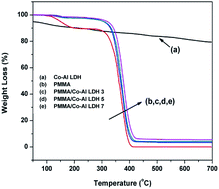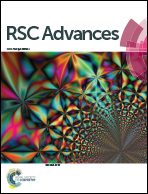Synthesis and characterization of exfoliated PMMA/Co–Al LDH nanocomposites via solvent blending technique
Abstract
The main aim of the present work is to examine the effect of Co–Al layered double hydroxide (LDH) concentration on the structural, thermal and rheological properties of poly(methyl methacrylate) (PMMA) nanocomposites. PMMA/Co–Al LDH nanocomposites were prepared by dispersing organically modified Co–Al LDH in the PMMA matrix via a solvent blending technique using methylene chloride as a solvent. The resultant samples were analyzed by Fourier transform infrared (FTIR) spectroscopy, X-ray diffraction (XRD), transmission electron microscopy (TEM), differential scanning calorimetry (DSC) and thermogravimetric analysis (TGA). The XRD and TEM results confirm the formation of exfoliated PMMA nanocomposites. The PMMA/LDH nanocomposites demonstrate higher thermal stability as compared to pristine PMMA. When 15% weight loss is selected as a point of consideration, the degradation temperature of PMMA/LDH nanocomposites containing 7 wt% of Co–Al LDH is 25 °C higher than that of pristine PMMA. The glass transition temperature (Tg) of PMMA nanocomposites is about 2–4 °C more than for pristine PMMA. The thermal degradation kinetics of different nanocomposites is also determined. The rheological studies elucidate that complex viscosity, storage and loss modulus diminish with increasing temperature from 150 to 190 °C.


 Please wait while we load your content...
Please wait while we load your content...